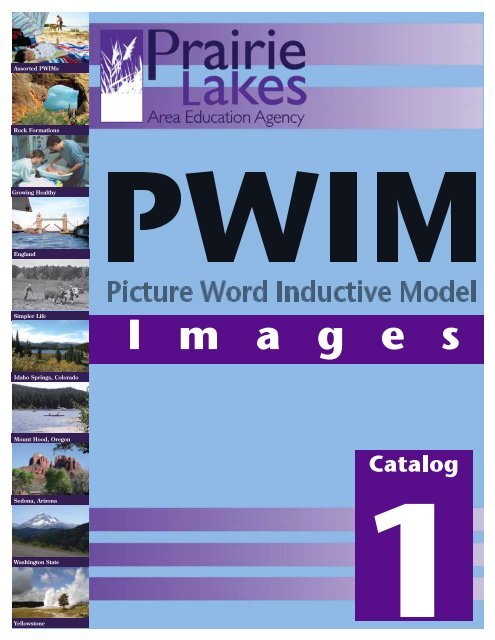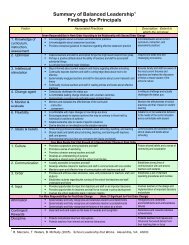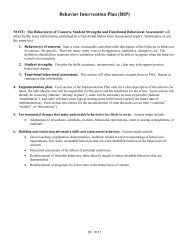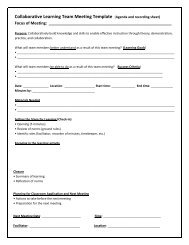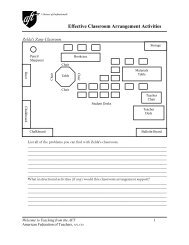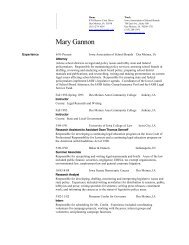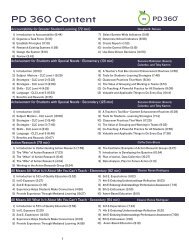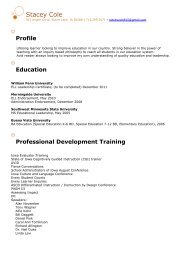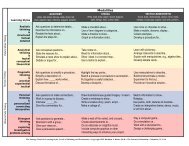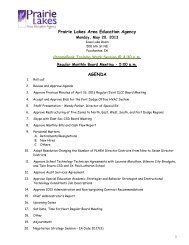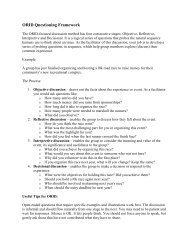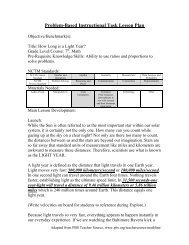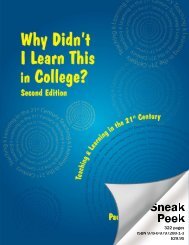I m a g e s - Prairie Lakes Area Education Agency
I m a g e s - Prairie Lakes Area Education Agency
I m a g e s - Prairie Lakes Area Education Agency
Create successful ePaper yourself
Turn your PDF publications into a flip-book with our unique Google optimized e-Paper software.
Assorted PWIMs<br />
Rock Formations<br />
Growing Healthy<br />
England<br />
PWIM<br />
Simpler Life<br />
I m a g e s<br />
Idaho Springs, Colorado<br />
Mount Hood, Oregon<br />
Sedona, Arizona<br />
Washington State<br />
Yellowstone
Every Child Reads: Excellence in Teaching © 2006 Iowa Department of <strong>Education</strong><br />
Description of the Picture Word Inductive Model (PWIM)<br />
Levels 1 and 2<br />
1 2<br />
The Picture Word Inductive Model (PWIM) is an inquiry oriented language arts strategy for teaching beginning readers<br />
and writers. Levels 1 and 2 of the PWIM are generally used for beginning readers, especially those in preschool<br />
through the end of grade 2 or beginning of grade 3, or struggling readers. The PWIM employs photographs containing<br />
familiar objects, actions, and scenes to elicit words in children’s listening and speaking vocabulary. This model helps<br />
students add words to their sight reading vocabulary, as well as their writing vocabulary. It also helps students discover<br />
phonetic and structural principles present in those words. This model includes both explicit instruction and concept formation<br />
lessons and is a multidimensional approach to literary development, one which encourages the use and integration<br />
of all actions and strategies emphasized in Every Child Reads. The PWIM requires continuous modeling of reading<br />
and writing by the teacher and can also be used to teach students how to use observation and analysis as they learn to<br />
read and write, comprehend and compose<br />
Calhoun, 1999<br />
Level 3<br />
The Picture Word Inductive Model is expanded to support in-depth inquiry into content domains other than language<br />
arts. This generally occurs in grades 3 and above when teachers are seeking a structured inquiry approach to teaching<br />
social science concepts and processes while simultaneously developing students’ language arts concepts and skills.<br />
3<br />
E. F. Calhoun, The Phoenix Alliance<br />
Each image in this catalog has been assigned one or more “level.”<br />
These are only recommendations. You will find that you are able to use<br />
these images in many different ways.<br />
Images are copyrighted. Reproduction of images is prohibited without written permission from copyright holder.<br />
Images…images from © 2003-2009 www.clipart.com, Photodisc, Ed Zimmerle, Sheri Simpson-Schultz, Ron Pomeroy, Claudia Kock,<br />
Instructional Resources Corporation.<br />
2 Picture Word Inductive Model
Photograph Selection Criteria Important<br />
The best practice for classroom teachers is to use images that are large enough that details are easily viewed<br />
and identified by students. The recommendation is that the photo be at least 20” x 30” which is the standard size<br />
PWIM image.<br />
• It should be a real photograph that clearly depicts one large scene, not multiple scenes or mini photographs in a<br />
collage.<br />
• The proportions of items in the photograph should not be distorted.<br />
• There should be a main feature and then many details so many words can be shaken out or located by students.<br />
• Colored photos or black and white pictures will work, but make sure the images are clear.<br />
• Be sensitive to students’ lives when selecting posters.<br />
• There should not be captions or titles printed on the photograph. Signs in the photograph are acceptable.<br />
• Photos should reflect attributes of a concept being studied, but do not need to be an example of the concept itself.<br />
For example, a poster of a camel in a desert area can support a unit on animal habitats as easily as a poster of elephants<br />
on a grassy plain.<br />
Index<br />
AP .......................................................Assorted PWIMs<br />
RF<br />
........................................................ Rock Formations<br />
GH.......................................................Growing Healthy<br />
ENG ...................................................................England<br />
SL<br />
................................................................. Simpler Life<br />
ISC ..........................................Idaho Springs, Colorado<br />
MHO ........................................... Mount Hood, Oregon<br />
SA<br />
.......................................................... Sedona, Arizona<br />
WASH ................................................ Washington State<br />
YLS ........................................... Yellowstone State Park<br />
* * Concepts taught should align with district Standards and Benchmarks in Language Arts, Science, and Social Studies.<br />
Picture Word Inductive Model 3
Welcome to the Possibilities of PWIM!<br />
Because there are 3 uses of the model, you will want to consider the following when selecting one or more photographs<br />
to support your unit:<br />
• Which Standards and Benchmarks will you teach to when using this photograph with a PWIM unit<br />
• For Level 1, is there a very familiar object or event in the photograph for children ages 3-8<br />
• For Level 1, will this photograph allow for the teaching and learning of the concepts of a word, a sentence, and a<br />
paragraph<br />
• For Level 2, will this photo help to embed language arts learning into a unit in science or social studies What<br />
non-fiction books will be needed to develop the content knowledge and vocabulary needed with the concepts<br />
selected Which Read Alouds, Talk Alouds, and Think Alouds will be planned to support the unit.<br />
• How will the unit help you meet the ultimate goal of PWIM - having STUDENTS read and write informative prose<br />
• For Level 3 PWIM, which photos will help to teach a large domain of study For example, if you are teaching a<br />
conceptual unit on habitats, which photos will help students understand grasslands, wetlands, freshwater, and<br />
salt water habitats Or, for a unit on ‘Why do people move, travel, and explore’, which photos will help students<br />
inquire into their community and a nearby larger city Which will help them consider current residents and past<br />
immigrants Which will help them understand transportation, education, occupations, goods and services, and<br />
recreation of these locations today and long ago<br />
*** Note: Level 3 photographs may be less detailed than levels 1-2 because multiple -photo use is encouraged to teach broad concepts.<br />
4 Picture Word Inductive Model
Moves of the PWIM!<br />
1. Select a picture.<br />
2. Ask students to identify what they see in the<br />
picture.<br />
3. Label the picture parts identified. (Draw a line<br />
from the identified object or area, say the word,<br />
write the word; ask students to spell the word<br />
aloud and then to pronounce it.)<br />
4. Read and review the picture word chart aloud.<br />
5. Ask students to read the words (using the lines on<br />
the chart if necessary) and to classify the words<br />
into a variety of groups. Identify common concepts<br />
(e.g. beginning consonants, rhyming words) to<br />
emphasize with the whole class.<br />
6. Read and review the picture word chart (say the<br />
word, spell it, say it again).<br />
7. Add words, if desired, to the picture word chart<br />
and to the word banks.<br />
8. Lead students into creating a title for the picture word chart. Ask students to think about the information on the<br />
chart and what they want to say about it.<br />
9. Ask students to generate a sentence, sentences, or a paragraph about the picture word chart. Ask students to<br />
classify sentences; model putting the sentences into a good paragraph.<br />
10. Read and review the sentences and paragraphs.<br />
Picture Word Inductive Model 5
Example of a Level 2 concept<br />
Communities<br />
People<br />
and their<br />
history<br />
<strong>Education</strong><br />
Des Moines, Iowa<br />
Urban<br />
Communities<br />
Other<br />
People<br />
and their<br />
history<br />
Storm Lake, Iowa<br />
Rural<br />
Communities<br />
<strong>Education</strong><br />
Government<br />
Transportation<br />
Locations<br />
Government<br />
Occupations<br />
Transportation<br />
Occupations<br />
Goods<br />
Rights and<br />
Responsibilities<br />
Resources<br />
and<br />
Industry<br />
Resources<br />
and<br />
Industry<br />
Rights and<br />
Responsibilities<br />
Locations<br />
Goods<br />
6 Picture Word Inductive Model
Example of a Level 3 PWIM Domain<br />
Reasons<br />
Explorers<br />
Space<br />
Discoveries<br />
Why do<br />
People<br />
Move,<br />
Travel,<br />
and<br />
Explore<br />
Reasons<br />
Sea<br />
Discoveries<br />
Destinations<br />
Destinations<br />
Explorers<br />
Land<br />
Reasons<br />
Discoveries<br />
Explorers<br />
Destinations<br />
Picture Word Inductive Model 7
1<br />
1<br />
AP 00001-01-00-00<br />
Feeding Lambs<br />
1<br />
AP 00002-01-00-00<br />
Grant’s Market<br />
1<br />
AP 00003-01-00-00<br />
Lisa’s Baby<br />
AP 00004-01-00-00<br />
Ambulance<br />
1 2<br />
1<br />
3<br />
3<br />
2<br />
AP 00005-01-02-03<br />
Playground, St. Simons Island, Georgia<br />
2<br />
AP 00006-01-02-03<br />
Boy and Bike, California<br />
2<br />
AP 00007-00-02-00<br />
Storytelling Around the Fire Tipi<br />
AP 00008-00-02-00<br />
Boy With Water Wings<br />
8 Picture Word Inductive Model
2 3<br />
AP 00009-00-02-00<br />
Tyrrell Museum Technician<br />
AP 00010-00-00-03<br />
Des Moines City and Freeway<br />
3 3<br />
3<br />
AP 00011-00-00-03<br />
Des Moines Walkway<br />
AP 00012-00-00-03<br />
Des Moines Cantilever Bridge<br />
3 3<br />
AP 00013-00-00-03<br />
Des Moines Middle Level Houses<br />
AP 00014-00-00-03<br />
Red Car, St. Simons Island, Georgia<br />
3 3<br />
AP 00015-00-00-03<br />
Lady on Motorcycle<br />
AP 00016-00-00-03<br />
Harris Teeter<br />
Picture Word Inductive Model 9
3 3<br />
AP 00017-00-00-03<br />
Saskatoon Center Car<br />
3 3<br />
AP 00018-00-00-03<br />
Saskatoon City of Bridges<br />
AP 00019-00-00-03<br />
Saskatoon Modest Houses<br />
2 3 1 2<br />
3<br />
AP 00020-00-00-03<br />
Neighborhood Road Work Paving (Saskatoon)<br />
AP 00021-00-02-03<br />
Airplane, Nepal<br />
1<br />
3<br />
2<br />
AP 00022-01-02-03<br />
Boat, Malaysia<br />
1<br />
3<br />
2<br />
AP 00023-01-02-03<br />
Camel, Egypt<br />
AP 00024-01-02-03<br />
Elephant, Kenya, East Africa<br />
10 Picture Word Inductive Model
1<br />
3 3<br />
AP 00025-01-00-03<br />
Field, Egypt<br />
AP 00026-00-00-03<br />
San Diego Harbor, California<br />
3 3<br />
AP 00027-00-00-03<br />
Radcliffe-on-Trent, England<br />
AP 00028-00-00-03<br />
Street Scene<br />
1 1 2<br />
AP 00029-01-00-00<br />
Teddy<br />
1<br />
3<br />
2<br />
AP 00030-01-02-00<br />
Snowman<br />
1 3<br />
AP 00031-01-02-03<br />
Weather<br />
AP 00032-01-00-03<br />
Farm, Nebraska<br />
Picture Word Inductive Model 11
2<br />
3 1<br />
3<br />
2<br />
AP 00033-00-02-03<br />
England<br />
2<br />
3 1<br />
3<br />
AP 00034-01-02-03<br />
Craft Table, California<br />
2<br />
AP 00035-00-02-03<br />
Garden, California<br />
1 3 1 3<br />
AP 00036-01-02-03<br />
Kid/Dog, Nepal<br />
AP 00037-01-00-03<br />
Kid/Read<br />
1 2 2<br />
AP 00038-01-00-03<br />
Schools Around World, England<br />
3<br />
AP 00039-01-02-03<br />
Watering Can<br />
AP 00040-00-02-03<br />
Father/Child in Study<br />
12 Picture Word Inductive Model
1 3<br />
2 3<br />
AP 00041-01-00-03<br />
Woman/Child Kitchen Scene<br />
AP 00042-00-02-03<br />
Harvesting Cotton<br />
1 2 2 3<br />
AP 00043-01-02-00<br />
Kids/Pigs in Wagon<br />
AP 00044-00-02-03<br />
Studying Flowers<br />
1 3<br />
1 2<br />
AP 00045-01-00-03<br />
Eating Lunch<br />
AP 00046-01-02-00<br />
Pumpkin Harvest<br />
1<br />
3<br />
2 2 3<br />
AP 00047-01-02-03<br />
Family Outing/Picnic<br />
AP 00048-00-02-03<br />
Adults Getting on Bus<br />
Picture Word Inductive Model 13
2<br />
3 2 3<br />
AP 00049-00-02-03<br />
Relay Race<br />
1 3 2 3<br />
AP 00050-00-02-03<br />
Rice Field<br />
AP 00051-01-00-03<br />
Piano and Flute Players<br />
2<br />
3 2 3<br />
AP 00052-00-02-03<br />
Science Lab<br />
AP 00053-00-02-03<br />
Space Shuttle<br />
2 3 1 2<br />
AP 00054-00-02-03<br />
Wheelchair Student<br />
3<br />
AP 00055-00-02-03<br />
Studying Snake<br />
AP 00056-01-02-03<br />
Horse<br />
14 Picture Word Inductive Model
1 2<br />
1 2<br />
3<br />
AP 00057-01-02-00<br />
Squeezing Grandpa<br />
AP 00058-01-02-03<br />
Dinner Table<br />
1 2<br />
1 2<br />
3<br />
AP 00059-01-02-00<br />
Mixing Fruit<br />
AP 00060-01-02-03<br />
Hauling Canoe<br />
1 2 2 3<br />
3<br />
AP 00061-01-02-03<br />
Vegetable Picking<br />
AP 00062-00-02-03<br />
Painting<br />
1 2<br />
3<br />
1 2<br />
3<br />
AP 00063-01-02-03<br />
Rollerblading<br />
AP 00064-01-02-03<br />
School Bus Travel<br />
Picture Word Inductive Model 15
2<br />
3 3<br />
AP 00065-00-02-03<br />
Grilling Hotdogs<br />
2 3<br />
2 3<br />
AP 00066-00-00-03<br />
Desert Rock Formation<br />
AP 00067-00-02-03<br />
San Francisco<br />
1 2 2 3<br />
AP 00068-00-02-03<br />
Streetcar<br />
AP 00069-01-02-00<br />
Birdhouse Construction<br />
1 2<br />
AP 00070-00-02-03<br />
Looking at the Stars<br />
3<br />
AP 00071-01-00-00<br />
Pretending Dress-Up<br />
AP 00072-00-02-03<br />
Mowing the Lawn<br />
16 Picture Word Inductive Model
2<br />
3 3<br />
AP 00073-00-02-03<br />
Workshop<br />
RF 00001-00-00-03<br />
Rock Formation<br />
3 3<br />
RF 00002-00-00-03<br />
Rock Formation<br />
RF 00003-00-00-03<br />
Rock Formation<br />
3 3<br />
RF 00004-00-00-03<br />
Rock Formation<br />
3<br />
RF 00005-00-00-03<br />
Rock Formation<br />
3<br />
RF 00006-00-00-03<br />
Rock Formation<br />
RF 00007-00-00-03<br />
Rock Formation<br />
Picture Word Inductive Model 17
3 3<br />
RF 00008-00-00-03<br />
Rock Formation<br />
3 3<br />
RF 00009-00-00-03<br />
Rock Formation<br />
RF 00010-00-00-03<br />
Rock Formation<br />
3<br />
RF 00011-00-00-03<br />
Rock Formation<br />
3<br />
RF 00012-00-00-03<br />
Rock Formation<br />
3<br />
RF 00013-00-00-03<br />
Rock Formation<br />
3<br />
RF 00014-00-00-03<br />
Rock Formation<br />
RF 00015-00-00-03<br />
Rock Formation<br />
18 Picture Word Inductive Model
3 3<br />
RF 00016-00-00-03<br />
Rock Formation<br />
RF 00017-00-00-03<br />
Rock Formation<br />
3 3<br />
RF 00018-00-00-03<br />
Rock Formation<br />
RF 00019-00-00-03<br />
Rock Formation<br />
2 3<br />
2 3<br />
RF 00020-00-02-03<br />
Rock Formation<br />
RF 00021-00-02-03<br />
Rock Formation<br />
2 3<br />
2 3<br />
RF 00022-00-02-03<br />
Rock Formation<br />
RF 00023-00-02-03<br />
Rock Formation<br />
Picture Word Inductive Model 19
3 3<br />
GH 00001-00-00-03<br />
Brushing Teeth<br />
3 3<br />
GH 00002-00-00-03<br />
Dentist<br />
GH 00003-00-00-03<br />
Washing Hands<br />
3<br />
GH 00004-00-00-03<br />
Washing Baby<br />
3<br />
GH 00005-00-00-03<br />
Weighing In<br />
3<br />
ENG 00001-00-00-03<br />
Big Ben and Parliament<br />
3<br />
ENG 00002-00-00-03<br />
Double Decker Buses (aerial view)<br />
ENG 00003-00-00-03<br />
Banks of the Thames<br />
20 Picture Word Inductive Model


